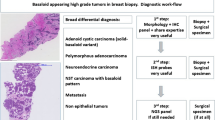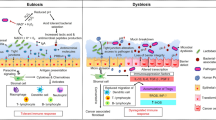Abstract
The aim of this study was to investigate the role of human papillomaviruses (HPVs) and alterations of p16INK4A in different squamous cell carcinomas (SCCs) of the head and neck region by screening these carcinomas for alterations in exon 2 of p16INK4A and for HPV DNA. A total of 42 samples of different SCCs of the head and neck were collected by biopsy or surgical resection. After DNA isolation, exon 2 of p16 was amplified and sequenced. HPV DNA was detected by applying a broad-spectrum polymerase chain reaction system. Mutations were found in 4 of our 42 samples. A total of 27 biopsies showed the presence of HPV DNA. All of the biopsies showing a mutation in exon 2 of CDK4 were HPV –positive, except the first biopsy of an oropharyngeal carcinoma. It might be possible that HPV infection and mutations in the exon 2 of CDK4 play a causal role in malignant transformation in a small number of squamous carcinomas of the head and neck region.


Similar content being viewed by others
References
zur Hausen H (1999) Papillomaviruses in human cancers. Proc Assoc Am Physicians 111(6):581–587
Liggett WHJ, Sidransky D (1998) Role of the p16 tumor suppressor gene in cancer. J Clin Oncol 16:1197–1206
Shanavaz SA, Bradley G, Regezi JA, Thakker N, Gao L, Hogg D, Jordan RC (2001) Patterns of CDKN2A gene loss in sequential oral epithelial dysplasias and carcinomas. Cancer Res 61:2371–2375
Berkhout RJ, Tieben LM, Smits HL, Bavinck JN, Vermeer BJ, ter Schegget J (1995) Nested PCR approach for detection and typing of Epidermodysplasia verruciformis-associated human papillomavirus types in cutaneous cancers from renal transplant recipients. J Clin Microbiol 33(3):690–695
Fischer M, von Winterfeld F (2003) Evaluation and application of a broad-spectrum polymerase chain reaction assay for human papillomaviruses in the screening of squamous cell tumours of the head and neck. Acta Otolaryngol 123:752–758
Lipman DJ, Pearson WR (1985) Rapid and sensitive protein similarity searches. Science 1227(4693):1435–1441
Riese U, Dahse R, Fiedler W, Theuer C, Koscielny S, Ernst G, Beleites E, Claussen U, von Eggeling F (1999) Tumor suppressor gene p16 (CDKN2A) mutation status and promoter inactivation in head and neck cancer. Mol Med 4:61–65
Hussussian CJ, Struewing JP, Goldstein AM, Higgins PA, Ally DS, Sheahan MD, Clark WH Jr, Tucker MA, Dracopoli NC (1994) Germline p16 mutations in familial melanoma. Nat Genet 8(1):15–21
Steinberg BM, DiLorenzo TP (1996) A possible role for human papillomaviruses in head and neck cancer. Cancer Metastasis Rev 15(1):91–112
Olshan AF, Weissler MC, Pei H, Conway K, Anderson S, Fried DB, Yarbrough WG (1997) Alterations of the p16 gene in head and neck cancer: frequency and association with p53, PRAD-1 and HPV. Oncogene 14:811–818
Walker GJ, Hussussian CJ, Flores JF, Glendening JM, Haluska FG, Dracopoli NC, Hayward NK, Fountain JW (1995) Mutations of the CDKN2/p16INK4 gene in Australian melanoma kindreds. Hum Mol Genet 4:1845–1852
Ranade K, Hussussian CJ, Sikorski RS, Varmus HE, Goldstein AM, Tucker MA, Serrano M, Hannon GJ, Beach D, Dracopoli NC (1995) Mutations associated with familial melanoma impair p16INK4 function. Nat Genet 10:114–116
Zhang SY, Lein-Szanto AJP, Sauter ER, Shafarenko M, Mitsunaga S, Nobori T, Carson DA, Ridge JA, Goodrow TL (1994) Higher frequency of alterations in the p16/CDKN2 gene in squamous cell carcinoma cell lines than in primary tumours of the head and neck. Cancer Res 54:5050–5053
Gonzalez MV, Pello MF, Lopez-Larrea C, Suarez C, Menendez MJ, Coto E (1995) Loss of heterozygocity and mutation analysis of the p16 (9p21) and p53 genes in squamous cell carcinoma of the head and neck. Clin Cancer Res 1(9):1043–1049
Gillison ML, Shah KV (2001) Human papillomavirus-associated head and neck squamous cell carcinoma: mounting evidence for an etiologic role for human papillomavirus in a subset of head and neck cancers. Curr Opin Oncol 13(3):183–188
Dürst M, Dzarlieva-Petrusevska RT, Boukamp P, Fusenig NE, Gissmann L (1987) Molecular and cytogenetic analysis of immortalized human primary keratinocytes obtained after transfection with human papillomavirus type 16 DNA. Oncogene 1(3):251–256
Munger K, Werness BA, Dyson N, Phelps WC, Harlow E, Howley PM (1989) Complex formation of human papillomavirus E7 proteins with the retinoblastoma tumor suppressor gene product. EMBO J 8(13):4099–4105
Werness BA, Levine AJ, Howley PM (1990) Association of human papillomavirus types 16 and 18 E6 proteins with p53. Science 248(4951):76–79
Chen TM, Pecoraro G, Defendi V (1993) Genetic analysis of in vitro progression of human papillomavirus-transfected human cervical cells. Cancer Res 53(5):1167–1171
Garrett LR, Perez-Reyes N, Smith PP, McDougall JK (1993) Interaction of HPV-18 and nitrosomethylurea in the induction of squamous cell carcinoma. Carcinogenesis 14(2):329–332
Acknowledgments
All HPV plasmids were kindly provided by Professor E.-M. de Villiers, Division Tumorvirus-Characterization, Deutsches Krebsforschungszentrum, Heidelberg, Germany. We thank U. Lüddecke for her substantial help. This study was supported by the Meyer-Struckmann-Stiftung and “Aktion Kampf dem Krebs e.V.” of the German Cancer Society.
Author information
Authors and Affiliations
Corresponding author
Rights and permissions
About this article
Cite this article
Fischer, M. Analysis of exon 2 of MTS1 in HPV-positive and HPV-negative tumors of the head and neck region. Eur Arch Otorhinolaryngol 264, 801–807 (2007). https://doi.org/10.1007/s00405-007-0258-4
Received:
Accepted:
Published:
Issue Date:
DOI: https://doi.org/10.1007/s00405-007-0258-4




